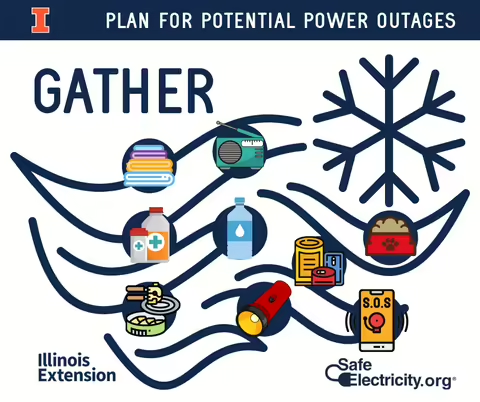SPRINGFIELD, Ill. – Winter can bring beautiful days for taking brisk walks, admiring the fresh snowfall, or creating snow angels. Winter’s fury can also produce icy roads, sub-zero wind chills, and power outages.
“Unfortunately, heavy snow and accumulating ice can easily bring tree limbs down on power lines, cutting off power to homes and businesses,” says Erin Hollinshead, executive director of Safe Electricity. “Even melting ice can be a problem because it can cause power lines to sag from the added weight.
“Planning for future outages brought on by severe winter conditions can make riding out a prolonged power outage safer and a little more comfortable,” Hollinshead advises.
How long it takes for your power to be restored depends on several factors: the extent of the storm’s destruction, the number of outages in your area, and when it becomes safe for utility personnel to get to the affected areas.
Take steps to help keep your family safe and comfortable during a winter storm long before one is forecast. A good way to start is to put an emergency kit together. Safe Electricity suggests starting with these items:
- Water: Stock up on bottled water for consumption. FEMA recommends storing at least one gallon per person, per day.
- Food: Have at least enough food, including non-perishable packaged or canned foods, juices, special foods for infants or the elderly, and snack foods, for three to seven days.
- Utensils: Without electricity, be sure you have a manual can opener, paper plates, and plastic utensils.
- Layers and added warmth: Gather blankets, pillows, and warm clothing items.
- Medicine and other items: Locate a first aid kit, medicine, prescription drugs, and any essential medical equipment.
- A charged cell phone: Most people are used to having their phones with them, but also have a portable, fully-charged power pack on hand.
Also gather:
- Toiletries, hygiene items, and moist towelettes.
- Flashlight and extra batteries.
- Battery-operated radio or a NOAA weather radio.
- List of emergency telephone numbers, including your local utilities.
- Toys, books, and games.
- Pet food and other pet-care items.
- Supplies for alternate heating methods, such as a fireplace or wood-burning stove.
In advance of a storm, have the power company or a tree-trimming professional remove limbs that could fall on power lines if they become covered in ice or snow. Only certified line clearance tree trimming professionals are authorized and allowed to trim trees near power lines.
"Insulate your home by installing storm windows or plastic covering on windows and caulk any cracks in your home," Hollinshead says. "Finally, make sure the heating system is in proper working order."
Other safety tips include:
- Use caution when using a portable generator.
- Never use a portable generator indoors, in a garage, or near windows or doors because they omit deadly carbon monoxide.
- Never plug a portable generator into a wall outlet. Doing so can create deadly backfeed, which occurs when electricity travels from the generator back through the power lines.
- Monitor the temperature in your home. Infants and elderly people are more susceptible to the cold.
- Avoid going outside. Downed power lines could be submerged in snow and ice, making them difficult to identify. Consider all downed and hanging lines energized and deadly.
Along with causing outages, wintery conditions can create hiccups in power delivery that include blinking lights or ebbs and flows in the amount of power that comes into your home. Although blinking lights can be a symptom of other problems such as loose wiring connections or overloaded circuits, they can also be caused by extreme weather conditions. When this happens, protect your circuits and appliances by switching off lights and unplugging devices.
For more information about preparing for a winter storm and electrical safety, visit SafeElectricity.org.
WRITER: Ann Augspurger, Safe Electricity, Communications Director
ABOUT SAFE ELECTRICITY: Safe Electricity is the award-winning, public awareness program of the Energy Education Council, a 501(c) 3 (not-for-profit organization) established in 1952 on the campus of the University of Illinois at Urbana-Champaign. With offices located in Springfield, Ill., Safe Electricity operates under the University of Illinois Extension and is led by the EEC Board of Directors. Since the Safe Electricity program was created in 2001, it has provided thousands of safety-minded resources to its more than 500 utility members from across the country to help save lives and reduce injuries.
ABOUT EXTENSION: Illinois Extension leads public outreach for University of Illinois by translating research into action plans that allow Illinois families, businesses, and community leaders to solve problems, make informed decisions, and adapt to changes and opportunities.
